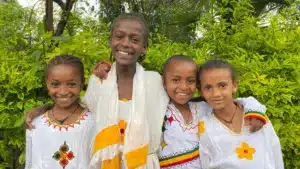Your Top Ten Adoption Questions Answered
Just starting your adoption journey? We have the answers to the most common questions about adoption below.
1. Why does adoption cost so much?
Adoption costs a lot because it’s a legal process involving dual government cooperation. Home studies, agency fees, and the legal documents required to make a child eligible for adoption are also part of the cost. Travel is also another factor for international adoption. The adopting family is typically required to travel once or twice to the adoptive child’s birth country during the adoption process, which adds to the expense.
2. Why does it take so long to adopt internationally?
It typically takes between six months and four years to complete an international adoption. This process takes time for several reasons:
1. The documentation required for adoptive families and the home study process can be lengthy.
2. The child is also required to go through a process to ensure eligibility, such as the termination of parental rights.
3. The country’s government also has a role in approving a family to adopt and working with foreign governments can also add to the process as they typically are without as many resources.
4. The length of the waiting family list, and the family’s place on this list can also make the process longer. However, this does not mean that there is not a need! The process is just slow-moving.
5. After a family has been matched and approved, the U.S. embassy then needs to issue a visa to the adoptive child and recognize the adoption. All of these factors can take a while!
3. Is there help with adoption costs?
Yes! There are a lot of organizations that help with adoption and adoption related costs. There are so many wonderful resources for families adopting children with special needs or older children in particular. For the full list of AGCI’s recommend resources, check out our Additional Resources Page.
We also strongly encourage families to consider fundraising as a way to help with adoption costs. It’s a wonderful way to engage with your local community and allow others to contribute and be a part of your cause.
4. Am I eligible to adopt?
Each country has its own specific requirements regarding adoptive families. There are also requirements within the U.S. and AGCI. The three primary categories that affect eligibility are: medical, criminal, and financial backgrounds. Once a family decides on the program or country that they’d like to adopt from, we can see if it’ll be a good fit or suggest other programs that might fit their circumstances.
5. What will the health of my adoptive child be like?
The health of adoptive children ranges a lot. For example, our China adoption program is all special needs in some way. The special need could be very minor, or require surgery or ongoing care. We talk with each prospective adoptive family to see what they’re open to and go from there. The greatest need right now is for families willing to adopt a child with moderate special needs that might need an initial corrective surgery or ongoing care.
6. Where’s the greatest need for adoptive families?
We need families who are open to adopting children of all age ranges and mild to moderate special needs, as well as older children and sibling groups.
7. Why can’t I adopt a healthy infant internationally?
A lot of countries are beginning to understand the value of domestic adoption. This is a positive thing for children and families, but it’s also why toddlers are typically the youngest age available for international adoption.
8. Why should I choose AGCI?
We believe in offering families a really high level of support and provide information to prepare families for their adoption journey.
From a broader standpoint, we are a truly child-centric organization. We have a holistic view of childcare that we bring into every country we work in. This means that when we train orphanage staff, we teach them how to care for children at the highest level. When we go into a country, we don’t just think about adoption; we think about what is the biggest need. For some communities, that’s not adoption, it’s family preservation or aging out support. We are sensitive to that and strive to do our best for children and their communities.
9. What’s the Hague Convention?
The Hague Convention is an international treaty that standardizes the adoption process. Many countries, including the United States, have signed this treaty. In addition to making the adoption process more transparent, it also involves the central authority more readily in the child placement process. It’s very costly for countries and agencies to become Hague compliant, which is why some countries choose not to comply. There are advantages and disadvantages to both Hague compliant and non-compliant countries. One advantage of non-compliant countries is that the adoption agency can be more involved in the placement of adoptive children. However, more countries are turning towards the Hague Convention as a way to minimize corruption and better standardize the adoption process.
10. How do children transition into their adoptive families?
Each child is unique and so is each transition! AGCI works hard to prepare families so the transition home can go as smoothly as possible. There are sometimes initial challenges when families first meet their adoptive child. Sometimes those challenges also manifest several months later when the child begins to test boundaries. All of these reactions are normal and part of developing a trusting relationship. AGCI supports families throughout this process and connects them with other adoptive families for questions and support. We’re always here for you! We also provide adoption education through the online learning platform, Families Are Forever.
Ready to get started? Visit our How to Get Started page and begin your adoption journey today!
Still have more questions? Here are a bonus 6 more of your top adoption questions answered!
1. How can we ensure that the child is a legitimate orphan?
There is a process to determine that a child is legally eligible for adoption. If the child’s birth country is a Hague country, the process must also be Hague compliant. Before issuing a visa, the US Embassy reviews the process to ensure that all procedures have been followed. While these measures to ensure legitimacy exist, it’s still important for families to choose an adoption agency that they fully trust. As adoption agencies are the ones pursuing relationships in-country, it’s particularly important that the family can trust that no documents have been falsified. It’s especially crucial to be sure that agencies do their due diligence in non-Hague countries where corruption can be more common.
2. Is the adoption final?
Yes. In most countries the legal process occurs in country and the adoption becomes final in country. If the country is a signatory to the Hague Convention, the adoption is permanent and irrevocable. If the country is not a signatory to the Hague Convention, re-adoption will ensure that the adoption is permanent and irrevocable under U.S. law. Before the child can be placed, they must first be legally relinquished by their birth parents or go through the abandonment process. To go through the abandonment process, the central authority needs to show that they have tried to contact all biological family members before the child can be placed for domestic or international adoption. If the family is responsive to contact, they must then decide that they are unable to care for the child or the government may reach this conclusion as well.
3. Do we have to go through re-adoption?
In most countries, if the child enters the U.S. on an IR-3 Visa, the child will enter the United States as a US citizen and re-adoption is not necessary for U.S. citizenship. However, if the child enters the U.S. on an IR-4 Visa, re-adoption is required to file for U.S. citizenship. Even if re-adoption is not necessary to obtain U.S. citizenship, AGCI strongly recommends that families pursue re-adoption for a number of other benefits. Re-adoption provides the adopted child with a birth certificate issued from their adoptive family’s home state, which can be very useful. Re-adoption protects the legal parent-child relationship under U.S. law regardless of changes to the adoption laws in the child’s birth country. Re-adoption also secures inheritance rights for an adopted child under states’ intestate laws. If the family plans on changing the adoptive child’s birth name, this can also be done during the re-adoption process. Once the adoptive child comes home, AGCI will provide information to the adoptive family on how to pursue re-adoption.
4. What is the requirement for post-adoption reports?
Post-adoption report requirements vary by program. There is often a series of reports required by a social worker. Some programs also require additional self-reports written by the adoptive family. It’s very important for families to comply with these reports for AGCI’s license and for country follow-ups. Additionally, these reports are an important support tool that provides families with practical benefits and an opportunity to ask questions and address any concerns.
5. Can AGCI work with families outside of the states we are licensed with?
Yes! While we are licensed to provide home study and post-adoption services in Oregon, Ohio, Kentucky, Michigan, Texas, Indiana, and Washington, families outside these states can also pursue adoption through AGCI. The majority of our adoptive families are actually outside of our licensed states! If a family would like to adopt through AGCI outside of the listed states, they will work with one of our cooperating agencies in their home state for home studies and post-adoption reports. AGCI will still remain the placing agency and primary point of contact. For a list of our cooperating agencies, click here.
6. Why does AGCI like to place children following the natural birth order of the family?
AGCI tries to maintain the natural birth order in adoptive families because we like to honor the place that the children hold within the family. For example, if an adoptive family has a 7-year-old child, we would try not to place a child over the age of 6 with that particular family. We’ve found that certain difficulties with transitions can be avoided when we follow the natural birth order. Different roles and behavior expectations are often associated with birth order. It’s also helpful to remember that many children placed within a family may not have lived in a family setting before. It can be helpful for adoptive children to learn how to behave in a family setting by learning from older siblings. Maintaining birth order is also important for children already in the family as the oldest child is often afforded certain privileges.
However, when it comes to placing waiting children or older children, AGCI frequently considers exceptions to this. In this scenario, we would prepare the family on how these placements can be unique.













